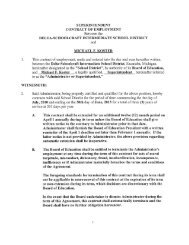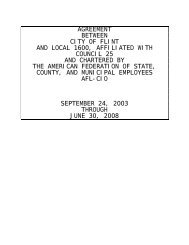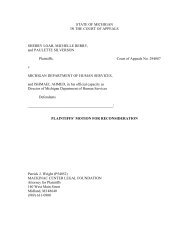The Cost of Remedial Education - Mackinac Center
The Cost of Remedial Education - Mackinac Center
The Cost of Remedial Education - Mackinac Center
Create successful ePaper yourself
Turn your PDF publications into a flip-book with our unique Google optimized e-Paper software.
<strong>The</strong> <strong>Cost</strong> <strong>of</strong> <strong>Remedial</strong> <strong>Education</strong>:<br />
How Much Michigan Pays When Students Fail to Learn Basic Skills<br />
<strong>Mackinac</strong> <strong>Center</strong> for Public Policy<br />
In this case we chose the per-year cost <strong>of</strong> remedial training in post-secondary<br />
institutions as the closest equivalent to what employers lose because <strong>of</strong> workers without<br />
basic skills. 18 That is, we assume that it costs businesses either directly or indirectly an<br />
equivalent amount <strong>of</strong> money to handle a worker lacking in basic skills as it would cost the<br />
community colleges or universities to remediate that worker. This is a conservative<br />
assumption because it assumes that the cost <strong>of</strong> providing someone with basic skills is neither<br />
a loss nor a gain, but is essentially “a wash.”<br />
Second, for the sake <strong>of</strong> convenience, we assume that everyone who graduates from<br />
high school lacking basic skills is successfully remediated by post-secondary institutions and<br />
that employers are left having to address the lack <strong>of</strong> skills among dropouts. This assumption,<br />
however, is somewhat at odds with the facts. Some dropouts in fact attend community<br />
colleges to receive their GEDs and remedial instruction. But this error is more than<br />
compensated for by the fact that not all high school graduates who are in need <strong>of</strong> remedial<br />
education obtain it from community colleges and universities. Only 59 percent <strong>of</strong> Michigan<br />
high school graduates attend a post-secondary institution. 19 And, as we have already<br />
discussed, only a fraction <strong>of</strong> those students obtain the remedial services they need.<br />
Nevertheless, for the purposes <strong>of</strong> our estimate, we are assuming that everyone who graduates<br />
from high school has basic skills or is covered by the costs we have already calculated for<br />
post-secondary institutions. We are assuming that employers have the task <strong>of</strong> coping only<br />
with the lack <strong>of</strong> basic skills among high school dropouts, an assumption that will yield us a<br />
conservative estimate <strong>of</strong> lost productivity.<br />
Third, we assume that dropouts are in need <strong>of</strong> as much remediation as the years <strong>of</strong><br />
high school they missed. A student who dropped out at the end <strong>of</strong> 10 th grade would require<br />
the equivalent <strong>of</strong> two years’ worth <strong>of</strong> remediation or would impose on employers the<br />
equivalent <strong>of</strong> the cost <strong>of</strong> those two years <strong>of</strong> remediation. This is also likely to be a<br />
conservative assumption in that most students who drop out were already several years<br />
behind their peers academically when they did so. Assuming that students who drop out at<br />
the end <strong>of</strong> 10 th grade had the basic skills required <strong>of</strong> a 10 th grader is making a generous<br />
assumption.<br />
We are assuming<br />
that employers<br />
must cope only<br />
with the lack <strong>of</strong><br />
basic skills among<br />
high school<br />
dropouts, an<br />
assumption that<br />
will yield us a<br />
conservative<br />
estimate <strong>of</strong> lost<br />
productivity.<br />
We are able to calculate the cost <strong>of</strong> remediation per full-time student in postsecondary<br />
schools—the cost we are assuming is equivalent to the loss <strong>of</strong> productivity<br />
experienced by employers due to employees’ lack <strong>of</strong> basic skills—by taking the total<br />
expenditure on remedial education and dividing it by the total number <strong>of</strong> full-time equivalent<br />
(FTE) students participating in those courses. Michigan community colleges, universities,<br />
and colleges spend approximately $89 million on remedial education. <strong>The</strong>re are a total <strong>of</strong><br />
18<br />
19<br />
This measure was chosen over any direct cost to employers who do pay to remediate their own<br />
workers because employers as a whole do not have incentives to engage in full remediation <strong>of</strong> their<br />
workers. <strong>The</strong>y understand that if they invest so much in a particular worker, that worker could be<br />
hired away by competitors who choose not to pay for full remediation. In other words, direct<br />
employer costs are highly unreliable as a measure <strong>of</strong> the true cost <strong>of</strong> full remediation.<br />
<strong>Education</strong> Week’s Quality Counts. Available at http://www.edweek.org/sreports/qc00/templates/statecomp.htm;<br />
accessed on August 16, 2000. Check box for “Michigan” then click “Compare!” button.<br />
September 2000 11













